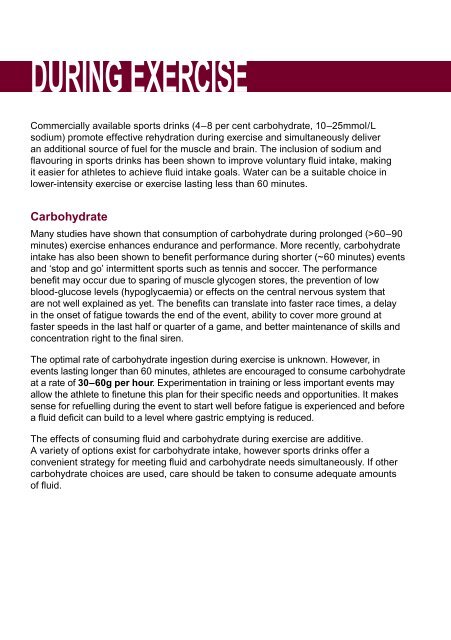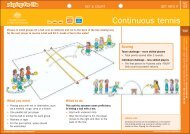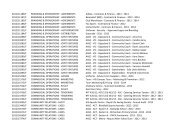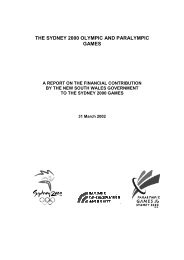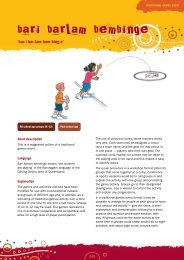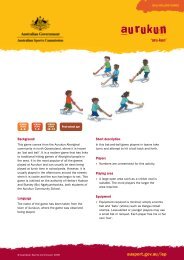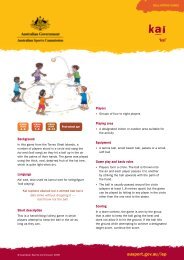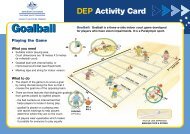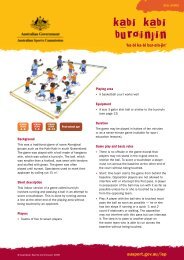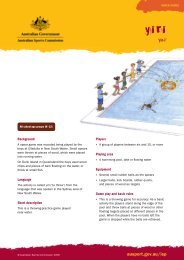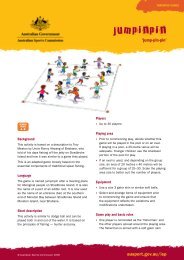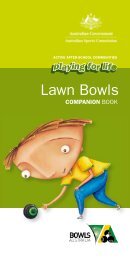Current Concepts in Sports Nutrition - Australian Sports Commission
Current Concepts in Sports Nutrition - Australian Sports Commission
Current Concepts in Sports Nutrition - Australian Sports Commission
You also want an ePaper? Increase the reach of your titles
YUMPU automatically turns print PDFs into web optimized ePapers that Google loves.
DURING EXERCISE<br />
Commercially available sports dr<strong>in</strong>ks (4–8 per cent carbohydrate, 10–25mmol/L<br />
sodium) promote effective rehydration dur<strong>in</strong>g exercise and simultaneously deliver<br />
an additional source of fuel for the muscle and bra<strong>in</strong>. The <strong>in</strong>clusion of sodium and<br />
flavour<strong>in</strong>g <strong>in</strong> sports dr<strong>in</strong>ks has been shown to improve voluntary fluid <strong>in</strong>take, mak<strong>in</strong>g<br />
it easier for athletes to achieve fluid <strong>in</strong>take goals. Water can be a suitable choice <strong>in</strong><br />
lower-<strong>in</strong>tensity exercise or exercise last<strong>in</strong>g less than 60 m<strong>in</strong>utes.<br />
Carbohydrate<br />
Many studies have shown that consumption of carbohydrate dur<strong>in</strong>g prolonged (>60–90<br />
m<strong>in</strong>utes) exercise enhances endurance and performance. More recently, carbohydrate<br />
<strong>in</strong>take has also been shown to benefit performance dur<strong>in</strong>g shorter (~60 m<strong>in</strong>utes) events<br />
and ‘stop and go’ <strong>in</strong>termittent sports such as tennis and soccer. The performance<br />
benefit may occur due to spar<strong>in</strong>g of muscle glycogen stores, the prevention of low<br />
blood-glucose levels (hypoglycaemia) or effects on the central nervous system that<br />
are not well expla<strong>in</strong>ed as yet. The benefits can translate <strong>in</strong>to faster race times, a delay<br />
<strong>in</strong> the onset of fatigue towards the end of the event, ability to cover more ground at<br />
faster speeds <strong>in</strong> the last half or quarter of a game, and better ma<strong>in</strong>tenance of skills and<br />
concentration right to the f<strong>in</strong>al siren.<br />
The optimal rate of carbohydrate <strong>in</strong>gestion dur<strong>in</strong>g exercise is unknown. However, <strong>in</strong><br />
events last<strong>in</strong>g longer than 60 m<strong>in</strong>utes, athletes are encouraged to consume carbohydrate<br />
at a rate of 30–60g per hour. Experimentation <strong>in</strong> tra<strong>in</strong><strong>in</strong>g or less important events may<br />
allow the athlete to f<strong>in</strong>etune this plan for their specific needs and opportunities. It makes<br />
sense for refuell<strong>in</strong>g dur<strong>in</strong>g the event to start well before fatigue is experienced and before<br />
a fluid deficit can build to a level where gastric empty<strong>in</strong>g is reduced.<br />
The effects of consum<strong>in</strong>g fluid and carbohydrate dur<strong>in</strong>g exercise are additive.<br />
A variety of options exist for carbohydrate <strong>in</strong>take, however sports dr<strong>in</strong>ks offer a<br />
convenient strategy for meet<strong>in</strong>g fluid and carbohydrate needs simultaneously. If other<br />
carbohydrate choices are used, care should be taken to consume adequate amounts<br />
of fluid.


